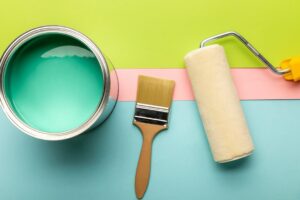Introduction
Spray painting is an efficient and effective way to achieve a smooth, professional-quality finish on various surfaces, from furniture and walls to cars and crafts. However, getting that perfect, even coat requires more than just pressing the nozzle. It involves preparation, technique, and the right tools.
This comprehensive guide will walk you through everything you need to know about spray painting, including expert techniques, common mistakes to avoid, and pro tips to achieve flawless results.
Why Choose Spray Painting?
Spray painting offers several advantages over traditional brush or roller methods:
- Smooth, Even Coverage: Unlike brushes and rollers, spray painting eliminates visible strokes and brush marks.
- Faster Application: Spray paint covers large areas quickly, making it a time-efficient option.
- Versatile Use: Suitable for wood, metal, plastic, walls, and even fabric.
- Professional Finish: When done correctly, spray painting provides a factory-quality finish.
- Minimal Waste: Reduces paint waste by ensuring even application.
Essential Tools & Materials for Spray Painting
Before you start, gather the necessary tools and materials to ensure the best results:
1. Types of Spray Paint
Choosing the right spray paint depends on your project:
- Acrylic Spray Paint: Fast-drying and ideal for general surfaces like wood and plastic.
- Oil-Based Spray Paint: Provides a durable finish, great for outdoor projects.
- Metallic Spray Paint: Gives a shimmering or glossy metallic effect.
- Enamel Spray Paint: Offers a high-gloss, durable finish, perfect for furniture and appliances.
- Chalk Spray Paint: Creates a matte, vintage look on furniture and décor.
2. Spray Paint Nozzles
Spray paint cans come with different nozzle types that affect the spray pattern:
- Standard Nozzles: Good for general-purpose use.
- Fan Nozzles: Spread paint in a wide, even fan pattern, reducing overlap marks.
- Adjustable Nozzles: Allow control over the spray width and intensity.
3. Protective Gear
Spray painting releases fumes and overspray, so proper protection is crucial:
- Respirator Mask: Prevents inhalation of paint fumes.
- Gloves: Protects hands from paint stains and chemicals.
- Safety Goggles: Shields eyes from airborne particles.
- Coveralls or Old Clothes: Avoids staining your clothes.
4. Additional Tools
- Drop Cloths or Plastic Sheeting: Protects surrounding areas from overspray.
- Painter’s Tape: Masks off areas you don’t want to paint.
- Sandpaper (120-220 Grit): Smooths surfaces before painting.
- Primer: Ensures better adhesion and long-lasting results.
- Clear Coat Spray: Seals and protects the final finish.
Preparation: The Key to a Professional Finish
1. Clean the Surface
A clean surface ensures better paint adhesion. Wipe down the surface using a mild detergent and water. For greasy or glossy surfaces, use a degreaser or rubbing alcohol.
2. Sanding & Smoothing
Rough surfaces or existing paint drips can ruin the finish. Use fine-grit sandpaper (120-220 grit) to smooth out imperfections. For metal surfaces, use a wire brush to remove rust.
3. Apply Primer
Priming is essential, especially on porous surfaces like wood and metal. A good primer:
- Blocks stains and prevents discoloration.
- Enhances paint adhesion.
- Reduces the number of paint coats needed.
Apply a thin, even coat of spray primer and let it dry completely before painting.
4. Mask Off Unwanted Areas
Use painter’s tape and plastic sheeting to cover areas you don’t want to be painted, such as glass, hinges, or surrounding surfaces.
Mastering Spray Painting Techniques
1. Shake the Can Properly
Before spraying, shake the can vigorously for at least 1-2 minutes to mix the paint and propellant. Shake periodically during use to maintain consistency.
2. Hold the Can at the Right Distance
Position the spray can 6-12 inches away from the surface. Holding it too close creates drips, while holding it too far results in uneven coverage.
3. Use Controlled, Even Strokes
Move the can in a steady, sweeping motion from left to right (or up and down), overlapping each pass by about 50%. Avoid stopping mid-spray, as this can cause uneven patches.
4. Apply Multiple Light Coats
Instead of trying to cover everything in one heavy coat, apply several thin layers. Wait for each coat to dry before applying the next.
- First coat: A light misting coat that establishes adhesion.
- Second coat: A more substantial coat that starts to build up color.
- Final coat: Ensures full opacity and smooth finish.
5. Maintain a Consistent Speed
Move the spray can at a consistent speed—not too fast (uneven coverage) and not too slow (drips and runs).
6. Spray in the Right Conditions
- Temperature: Ideal range is 50-85°F (10-29°C).
- Humidity: Avoid high humidity, as it can cause paint to dry too slowly or create a cloudy finish.
- Wind: Avoid spraying in windy conditions to prevent overspray.
7. Drying & Curing Time
- Touch dry: 15-30 minutes
- Handle dry: 1-2 hours
- Fully cured: 24-48 hours
Always check the manufacturer’s instructions for specific drying times.
Common Spray Painting Mistakes & How to Fix Them
1. Drips and Runs
Cause: Holding the can too close or spraying too much in one spot.
Fix: Let the paint dry completely, then lightly sand the drips and reapply thin coats.
2. Uneven Coverage
Cause: Moving too quickly or not overlapping strokes.
Fix: Apply additional coats in slow, even strokes, maintaining a consistent speed.
3. Paint Bubbling
Cause: Spraying in high humidity or applying a second coat before the first is dry.
Fix: Let the paint dry completely, sand out bubbles, and reapply paint.
4. Paint Cracking
Cause: Applying heavy coats or painting over an incompatible surface.
Fix: Sand the cracked areas, use a primer, and apply thin, even coats.
5. Overspray on Unwanted Areas
Fix: Wipe off immediately if wet. If dry, use rubbing alcohol or a light sanding to remove excess paint.
Sealing & Protecting the Paint Job
1. Apply a Clear Topcoat
For extra durability, apply a clear spray sealer or polyurethane coat, especially for furniture, outdoor projects, or high-use items.
2. Allow Proper Curing Time
Even if the paint feels dry, it takes 24-48 hours to fully cure. Avoid handling or exposing the surface to moisture before then.
Conclusion
Spray painting is a powerful technique for achieving a professional, even finish on various surfaces. Following the right preparation steps, using proper spray techniques, and avoiding common mistakes, you can create stunning results every time.
With patience, practice, and attention to detail, you’ll master the art of spray painting and transform your projects with a flawless finish! Want to learn how and/or faster? Contact us.





